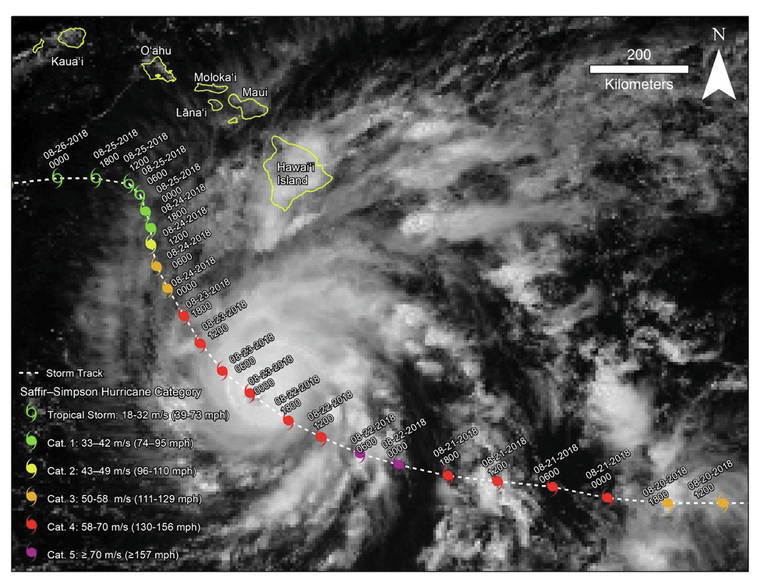LIHU‘E — A recent study led by University of Hawai‘i researchers analyzed the impacts of August 2018 Hurricane Lane, detailing both fire and rain produced as a result of the storm, and how those complications affected emergency response.
The study was published in the Bulletin of the American Meteorological Society found that preceding moisture conditions exacerbated fire hazards, and both fire and rain severity were influenced by the hurricane environment and local topographic features.
Conditions at the edge of the storm resulted in dry windy weather conducive to fire, researchers found, while closer to the storm center, the incredibly moist atmosphere lifted by Hawai‘i’s mountains brought intense, long-lasting rainfall.
The simultaneous occurrence of rain-driven flooding and landslides, strong winds and multiple fires complicated the emergency response across the state.
According to the Central Pacific Hurricane Center, Hurricane Lane was the fifth category 5 hurricane on record in the Pacific basin. The storm impacted the Hawaiian Islands over a four-day period in August 2018, dropping more than 36 inches of rain on Kaua‘i.
Hawaii Island received an average of 17 inches of rainfall, with a four-day single-station maximum of 57 inches, making Hurricane Lane the wettest tropical cyclone ever recorded in Hawai‘i.
“In this study, we document what we believe to be the first instance of a hurricane causing both heavy rainfall and contributing to multiple instances of fire simultaneously,” said Alison Nugent, lead author of the study and assistant professor of Atmospheric Sciences in UH Manoa’s School of Ocean and Earth Science and Technology (SOEST).
A team of UH Manoa and East-West Center scientists analyzed multiple aspects of the storm’s meteorology and climatology, the environmental conditions leading up to the storm, and documented the associated societal impacts.
“The surprising thing about Hurricane Lane was that, despite never making landfall, the storm caused considerable damage and disruptions across the state from two rather contradictory things: fire and rain,” said Nugent. “Severe flooding on the windward side of Hawai‘i Island built over several days, and multiple fires initiated on the leeward sides of Maui and O‘ahu within hours of each other. Hurricane Lane is one of only three documented cases of hurricanes influencing wildland fire risk in real-time.”
In Hawai‘i, landfall by hurricanes is relatively rare due to persistent vertical wind shear over the islands, which weakens hurricanes by essentially tipping them over, according to UH . However, when hurricanes do occur near Hawai‘i, the geography of the islands can exacerbate the hazards. The nearly 750 miles of coastline makes much of the state susceptible to coastal flooding, and the mountainous topography can enhance high-intensity rainfall, as well as intensifying wind speeds. In addition, the steep mountainous terrain can enhance flash flooding and trigger landslide events.
The study highlights Hawai‘i’s vulnerability to natural hazards and reveals that these events can place significant constraints on emergency responders. This research also demonstrates UH Manoa’s technical expertise across multiple disciplines—climatology, meteorology, water resources, fire science—to assess and predict the impacts of natural hazards and other climate-related events.
In the future the team plans to develop the analytical approaches and Hawai‘i-focused climate products needed to assess and prepare for future impacts, especially in the context of a changing climate where intensity and frequency of extreme events is likely to increase.
•••
Jessica Else, editor-in-chief, can be reached at 245-0457 or jelse@thegardenisland.com.


